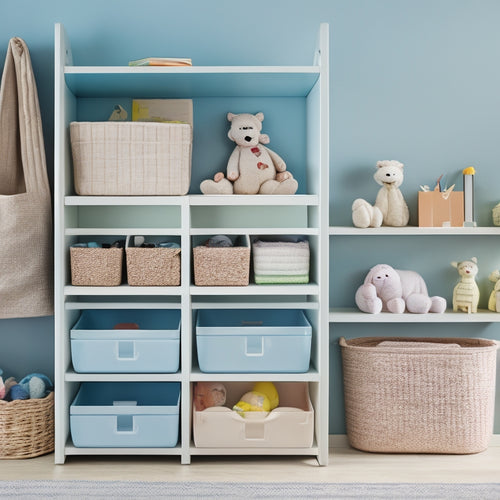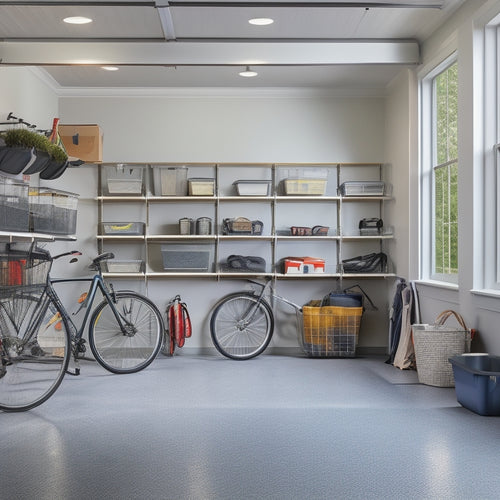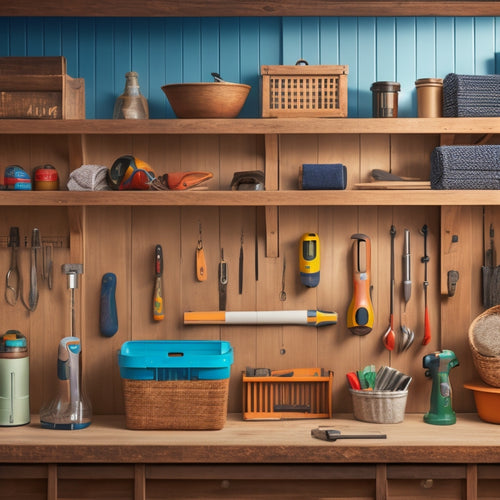
Pegboard Woes: Uncover Common Installation Mistakes Now
Share
I've been there too - frustrated with my pegboard, wondering why it's not living up to its organizational potential. But then I realized I was making some rookie mistakes. Like not planning my layout before installation, overcrowding my hooks, and not choosing the right accessories for my tools. And let's not forget about securing my pegboard properly - I didn't want it to come crashing down! Now I know better, and I'm about to spill all my hard-earned wisdom. Want to learn how to avoid these common installation mistakes and create a workspace that's both functional and fabulous?
Key Takeaways
• Plan your pegboard layout before installation to avoid clutter and ensure functional storage.
• Choose the right hooks and accessories for your tools to prevent overcrowding and accidents.
• Secure your pegboard properly with reliable hardware and sturdy brackets to avoid frustration.
• Balance weight capacity by spreading heavier and lighter tools, and consider reinforcement options.
• Regularly maintain your pegboard by tidying up, sweeping, and wiping down the surface for durability.
Pegboard Installation Pitfalls
When I'm installing a pegboard, I've learned the hard way that skipping a few crucial steps can lead to a wobbly, unreliable storage system that's more frustrating than functional. My biggest mistake was rushing into the installation process without planning the pegboard layout.
I didn't consider the tool organization, and as a result, my pegboard ended up being a cluttered mess. To avoid this pitfall, I now take the time to map out the layout, grouping similar tools together and leaving enough space between hooks to prevent overcrowding.
Common Mistakes to Avoid
My most epic fails in pegboard installation can be traced back to a handful of rookie mistakes that I've since learned to avoid. One major blunder wasn't planning my tool organization strategy beforehand, resulting in a cluttered and inefficient pegboard.
I also didn't optimize my space correctly, wasting valuable real estate on unnecessary hooks and accessories. To avoid these mistakes, I now take the time to assess my tool collection and design a layout that maximizes space optimization.
I also make sure to choose the right hooks and accessories for each tool, ensuring a snug and secure fit. By avoiding these common mistakes, I've been able to create a pegboard that's both functional and visually appealing.
Hook and Accessory Errors
I've lost count of how many times I've struggled with hook and accessory errors, only to realize that I'd chosen the wrong pegs for my tools or overloaded my pegboard with too many hooks. It's a rookie mistake, but it's easy to fall into the trap.
To avoid this, I make sure to double-check the accessory compatibility before making a purchase. I also consider the pegboard layout and tool organization, ensuring that each hook has enough space to breathe. A stable hook is key to preventing tools from falling off, and I've learned to prioritize hook stability over aesthetics.
Securing Your Pegboard Properly
Securing your pegboard to a sturdy surface is essential, as a flimsy installation can lead to a world of frustration and disorganization. I've learned the hard way that a little extra effort upfront saves me from a lot of headaches down the line.
When it comes to mounting techniques, I swear by using reliable hardware solutions that can withstand the weight of my tools. Stability concerns are a thing of the past when I reinforce my pegboard with sturdy brackets and screws.
Don't be like me, scrambling to fix a wobbly pegboard in the middle of a project. Take the time to get it right, and you'll be enjoying a clutter-free workspace in no time. Trust me, your tools (and your sanity) will thank you!
Overcoming Limited Weight Capacity
By the time I loaded up my pegboard with all my favorite tools, I realized that weight capacity was going to be a major issue. Whoops! I didn't think that one through.
To avoid a pegboard collapse, I'd to get creative with weight distribution. Here are a few tricks I learned:
-
Spread the weight: Balance heavier tools with lighter ones to prevent strain on a single hook.
-
Use reinforcement options: Consider adding extra support brackets or screws to make certain the pegboard can handle the load.
-
Choose the right hooks: Select hooks designed for heavier tools or opt for reinforced pegboard-specific hooks.
Maintenance and Upkeep Essentials
To maintain my pegboard from devolving into a cluttered mess, I make it a habit to regularly tidy up and perform some essential maintenance tasks.
I've developed a few cleaning techniques that work wonders, like using a soft-bristled brush to sweep away dust and dirt, and a damp cloth to wipe down the surface. This helps uphold the material durability of my pegboard, ensuring it remains sturdy and functional.
I also take the time to reassess my storage solutions, rearranging hooks and bins to optimize layout flexibility and keep frequently used tools within easy reach.
Customization and Upgrade Options
I've found that upgrading my pegboard with custom hooks and accessories can make all the difference in maximizing its storage potential and keeping my workspace organized. It's amazing how a few tweaks can elevate the entire system.
Here are three ways to take your pegboard to the next level:
-
Material choices matter: Experiment with different materials, such as hardwood or aluminum, to create a unique look that suits your style.
-
Design tweaks for functionality: Add custom hooks, bins, or trays to cater to your specific tool needs, ensuring everything has its designated spot.
-
Aesthetic enhancements: Incorporate layout variations, like asymmetrical designs or colorful accents, to add visual appeal and make your pegboard a statement piece in your workshop.
Frequently Asked Questions
Can I Use Pegboard in Humid Environments Like Bathrooms or Kitchens?
I'm hesitant to use pegboard in humid environments like bathrooms or kitchens, as moisture can seep into the hardboard, causing water damage and compromising its structural integrity - it's a recipe for disaster!
How Do I Prevent Pegs From Falling Out Over Time?
"I'm tired of pegs falling out! To prevent this, I use a screw type that securely fastens into the peg hole, ensuring a snug fit that withstands wear and tear - no more pesky pegs on the floor!"
Are There Any Eco-Friendly or Sustainable Pegboard Options Available?
I'm obsessed with going green, and I'm thrilled to discover eco-friendly pegboard options! Bamboo alternatives and reclaimed materials are a game-changer - I can finally organize my tools without killing the planet (or at least, my conscience)!
Can I Cut Pegboard to Fit a Custom Space or Size?
"I'm a DIY enthusiast, and I've resized pegboards to fit custom spaces with ease. I simply measure, mark, and cut the pegboard using a jigsaw or circular saw - voila, a custom-fit pegboard that's perfect for my unique space!"
Are Pegboards Compatible With All Types of Wall Materials?
"I've learned the hard way that pegboards aren't one-size-fits-all; I've battled with wonky wall types and material limitations - from flimsy drywall to stubborn concrete, some pegboards just don't play nice with certain walls."
Related Posts
-

Storage Bins for Shelves to Keep Clutter at Bay
You're looking for a way to keep your shelves organized and clutter-free, and storage bins are the perfect solution t...
-

Bin Garage Storage Ideas for Maximizing Space
You can greatly maximize your garage's storage space by utilizing vertical space with ceiling storage bins, stacking ...
-

What Tools Do I Need for a DIY Wall Organizer
You'll need a variety of tools to complete a DIY wall organizer project. Essential measuring tools include a tape mea...


